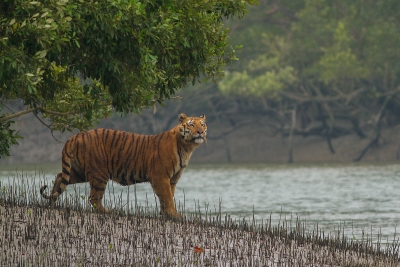
Believed to be named after a mangrove species called sundari, the Sundarbans is the world’s largest mangrove forest. It marks the area where land meets sea and freshwater meets seawater. Covering a vast area that spans more than 10,000 sq. km., the Sundarbans straddles the two countries of India (West Bengal) and its neighbour Bangladesh. While around 60 % of the total area falls in Bangladesh, the rest is in India. One of the last preserves of the endangered Bengal tiger, the region is said to be the only mangrove habitat of this big cat. The area is also part of the world’s largest delta, showing an incredible level of biodiversity both in flora and fauna. It is said to support more than 300 species each of plants, animals, and birds. This includes many threatened and endangered animals too. Marked by a chain of tidal waterways, mudflats, and tiny islands of salt-tolerant mangrove forests, it is an impressive representation of continuing ecological processes. It was declared a UNESCO World Heritage Site in the latter half of the 20th Century.
Wildlife
Though the Bengal tiger is the most noted species here, several other animals, amphibians, and reptiles can be spotted in the area. They include estuarine crocodiles, fishing cats, common otters, water monitor lizards, Gangetic dolphins, snubfin dolphins, river terrapins, turtles such as olive ridley turtles, green sea turtles, hawksbill turtles, a few species of sharks and rays, wild boars, spotted deer, porcupines, rhesus macaques, king cobras, common cobras, banded kraits, Russell’s vipers, pythons, checkered keelbacks, and green whip snakes. Herons, egrets, kingfishers, woodpeckers, storks, owls, terns, flycatchers, sunbirds, flowerpeckers, cormorants, storks, orioles, bitterns, babblers, pigeons, sandpipers, spoonbills, darters, eagles, seagulls, teals, partridges, wild geese, and ducks are some of the local and migratory birds that can be found in the region.
Threats
- Located as it is in the coastal region of the Bay of Bengal, the Sundarbans has always been threatened by cyclones and tidal waves. This has only increased with global warming and climate change. These factors have led to increasing temperatures and sea-level rise. A recent study found that when more and more (salinated) seawater enters land, coupled with hotter temperatures, they affect the vegetation of the region. If they gradually begin to disappear, the spotted deer in the region would too. Since the spotted deer is the Bengal tigers top prey, the big cat will be affected too.
- Not just that. The study added that without adequate prey, the chances of tigers venturing into human territory could go up, resulting in increased incidence of human-animal conflict.
- As it is, the tiger population has been a cause of concern, with only a few thousands left in the wild today. Along with the results of the study, other aspects such as encroachment and development too are reasons for concern.
But there’s good news!
According to the census conducted during the first half of 2020, the number of tigers in Sundarbans increased by eight to reach 96. Since 2016, the big cats number has been increasing, and this is said to be the highest since then. This news is particularly heartening because of the numerous threats the species faces.
Picture Credit : Google



